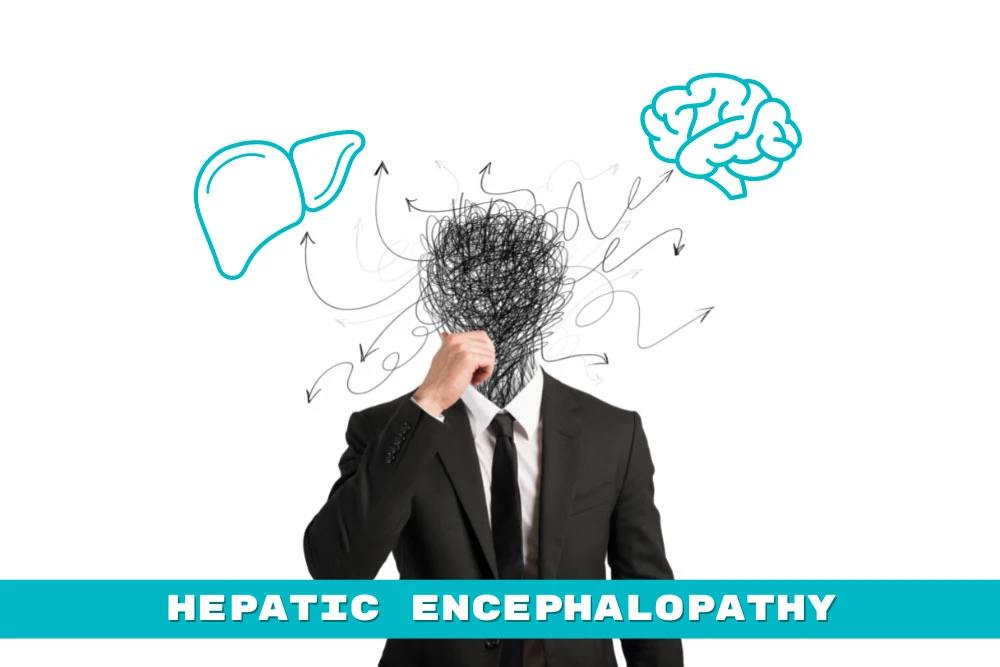Hepatic encephalopathy (HE) is a complex neuropsychiatric syndrome caused by liver dysfunction, typically seen in patients with chronic liver disease or acute liver failure.
Case Presentation
A 55-year-old male presents to the emergency department with confusion, disorientation, and altered level of consciousness. His family reports a history of chronic liver disease secondary to alcohol abuse. On examination, the patient exhibits asterixis (flapping tremor) and jaundice. His vital signs are stable, but he appears lethargic and is unable to answer questions coherently. Laboratory results reveal elevated serum ammonia levels, deranged liver function tests, and prolonged prothrombin time. Imaging studies show signs of cirrhosis without any acute intracranial abnormalities.
Based on the presentation and laboratory findings, what is the most likely diagnosis?
The most likely diagnosis is hepatic encephalopathy (HE). This condition is characterized by a decline in brain function due to severe liver disease. The key features supporting this diagnosis in the case include the patient’s history of chronic liver disease, the presence of asterixis, elevated serum ammonia levels, and the exclusion of other acute intracranial abnormalities.
Introduction and Explanation of Hepatic Encephalopathy
Hepatic encephalopathy (HE) is a complex neuropsychiatric syndrome caused by liver dysfunction, typically seen in patients with chronic liver disease or acute liver failure. It results from the accumulation of toxins in the bloodstream, which are normally detoxified by the liver.
Etiology
Hepatic encephalopathy most commonly occurs in patients with cirrhosis, which can result from chronic hepatitis, alcohol abuse, nonalcoholic fatty liver disease, or other liver conditions. Acute liver failure can also precipitate HE.
Pathophysiology
The liver’s inability to adequately filter toxins, particularly ammonia, leads to their accumulation in the blood. These toxins cross the blood-brain barrier and affect neurotransmission, causing cerebral edema and alterations in mental status. The exact mechanisms are complex and involve multiple factors including oxidative stress, inflammation, and impaired astrocyte function.
Possible Triggering Factors
Several factors can precipitate or worsen hepatic encephalopathy:
Gastrointestinal Bleeding: Blood breakdown in the gut increases ammonia production.
Infections: Systemic infections can exacerbate HE by inducing inflammatory responses and increasing metabolic demands on the liver.
Electrolyte Imbalances: Hyponatremia and hypokalemia can contribute to HE.
Dehydration: Reduced blood flow to the liver impairs its ability to detoxify ammonia.
Constipation: Slow bowel transit increases ammonia absorption from the gut.
Medications: Certain drugs, such as sedatives or diuretics, can trigger HE by various mechanisms including dehydration and electrolyte disturbances.
Renal Dysfunction: Reduced renal clearance of ammonia and other toxins can precipitate HE.
Excessive Dietary Protein: High protein intake can lead to increased production of ammonia from gut bacteria.
These triggers highlight the multifactorial nature of hepatic encephalopathy and the need for comprehensive management of patients with liver disease to prevent exacerbations.
Signs and Symptoms
The clinical presentation of HE can range from subtle cognitive changes to profound coma. Symptoms include:
Confusion and disorientation
Altered level of consciousness
Asterixis (flapping tremor)
Personality changes
Slurred speech
Motor disturbances
In severe cases, stupor and coma

Diagnosis
Diagnosis of HE is primarily clinical, supported by laboratory and imaging studies:
Clinical assessment: Neurological examination revealing asterixis, altered mental status.
Laboratory tests: Elevated serum ammonia levels, liver function tests, coagulation profile.
Imaging studies: CT or MRI to rule out other causes of encephalopathy.
West Haven Criteria for Hepatic Encephalopathy:
Stage 0 (Minimal HE)
- No detectable changes in personality or behavior
- No asterixis (flapping tremor)
- Subtle abnormalities in psychometric tests or neurophysiological parameters
Stage 1 (Mild HE)
- Altered mood and sleep patterns (e.g., euphoria, depression, irritability, insomnia, hypersomnia)
- Shortened attention span, impaired addition or subtraction
- Slightly confused, with a lack of awareness
- Asterixis may be present
Stage 2 (Moderate HE)
- Lethargy or apathy
- Disorientation to time and place
- Obvious personality changes, inappropriate behavior
- Slurred speech
- Asterixis more obvious
Stage 3 (Severe HE)
- Marked confusion
- Disorientation to time and place, gross disorientation
- Incoherent speech, somnolence to semi-stupor
- Marked asterixis
- Response to stimuli is still present
Stage 4 (Coma)
- Unconscious, unresponsive to pain
- Coma (with or without response to painful stimuli)
- No asterixis
Prognosis
The prognosis of HE depends on the underlying liver disease’s severity and the patient’s response to treatment. Early stages of HE (grades I-II) are generally reversible with appropriate management, while advanced stages (grades III-IV) have a poorer prognosis and higher mortality rates.
Epidemiology
HE occurs in 30-45% of patients with cirrhosis and in 10-50% of those with portosystemic shunts. It is a major complication of liver disease and a significant cause of morbidity and mortality.
Prevention and Management
Prevention of HE involves managing risk factors and underlying liver disease.
Lifestyle modifications: Reducing alcohol intake, managing weight, and controlling diabetes.
Medical management: Use of lactulose and rifaximin to reduce ammonia production and absorption.
Monitoring: Regular follow-up and monitoring of liver function tests.
Review question
Conclusion
Hepatic encephalopathy is a serious condition resulting from liver dysfunction, leading to neuropsychiatric symptoms. Early recognition and appropriate management are crucial for improving patient outcomes. Understanding the pathophysiology, clinical features, and treatment strategies of HE is essential for medical students and healthcare professionals managing patients with liver disease.
Study with MedBrane
If you’re keen to deepen your understanding of internal medicine, give the MedBrane app a try. It’s free and offers a great way to gauge what you already know through thorough exam simulations. Plus, you can learn as you go with in-depth explanations for every question.
Also you can follow us on Instagram @medbrane for more material for medical students and study tips!

